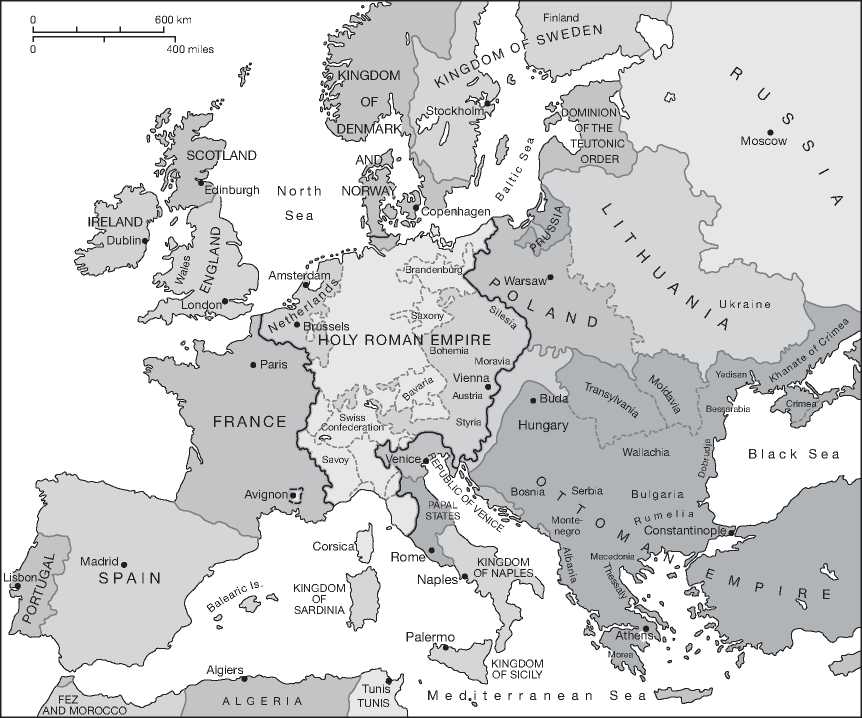In central Europe, more centralized government institutions also emerged in the twelfth century. In 1152 Frederick Barbarossa (ruled 1152-90) was chosen as the head of the Holy Roman Empire, a confederation of principalities, duchies, cities, bishoprics, and other types of regional government stretching from Denmark to Rome and from Burgundy to Poland. The emperor himself was from the Hohenstaufen family, the hereditary rulers of the duchy of Swabia in what is now southern Germany. Like his contemporaries in England and France, Frederick Barbarossa appointed officials to oversee the Empire, developed royal courts of justice, and required vassals to take oaths of allegiance.
Three primary and related problems prevented subsequent emperors from transforming the Empire into a centralized state. First, the various regional states, particularly the larger and more powerful among them, succeeded in keeping the emperorship an elected office. Until the middle of the fifteenth century, men from various powerful regional dynasties - the Luxembourgs, the Wittelsbachs, the Habsburgs - all vied for the office, as they made strategic marriages with women from each other’s families and other ruling houses, through which they expanded and consolidated their family holdings. In 1438 the emperorship went to Albert II of Habsburg, and it would remain with the Habsburgs with only one short break until the Empire was dissolved in 1804. Despite this continuity, not until the mid-sixteenth century were Habsburgs relatively assured the office would be theirs; the election of Charles V in 1519 still cost

Map 5 Europe in 1559.
Enormous amounts of money and involved extensive political maneuvering. Thus even if they happened to be emperor, the Habsburgs and other rulers of central European regional territories put their main efforts into their inherited family lands, developing armies, appointing officials, and often establishing representative institutions called Diets (Landtage). The smaller territories, including more than fifty imperial cities and thousands of free imperial knights who might hold only a few square miles, worried about being swallowed up by their larger neighbors, but their support of stronger imperial power to counter this was sporadic.
Second, the battle for power between popes and secular rulers, which had taken place all over central and western Europe in the medieval period, was particularly strong in the Empire, as the popes claimed the right to crown emperors, and emperors claimed authority over papal lands in Italy. Gradually both of these claims disappeared. With the Golden Bull of 1356, a decree issued by the Imperial Diet and Emperor Charles IV (ruled 1355-78), seven leading territorial rulers in Germany, three of them archbishops and
Four of them secular princes, became the electors who chose the emperor, and a papal coronation was no longer required. The emperors lost their permanent power in Italy, but because they often still allied with Italian cities in disputes with the pope, the popes were unwilling to cede power over taxation or the appointment of church officials to the emperors in the ways they did - or were forced to do - with western European monarchs. This situation became particularly significant in the early sixteenth century, when papal tax collectors were desperately trying to cover the costs of the building of St. Peter’s in Rome, and increased their activities in the Empire substantially. As we will see in chapter 5 , papal tax collection was one of the sparks that set off the Protestant Reformation, and the emperor’s feeble hold over German territorial princes was an important factor in its spread. The resulting religious divisions in the Empire weakened imperial institutions even further.
Third, for much of the sixteenth century the Habsburgs were engaged in frequent warfare with the Valois rulers of France. The prelude to this conflict was war in Italy. Aragon and France both claimed the kingdom of Naples and Sicily in southern Italy through different lines of descent, and the death of its ruler in 1494 provided an opportunity to enforce these claims. Naples was also involved in shifting alliances in Italy itself, and in 1494 entered into an agreement with Florence to take over Milanese territories; Milan asked France for support, and French armies invaded Italy, moving quickly all the way to Naples. Spanish armies retook Naples a decade later, and Spanish and German troops together pushed French troops out of Italy. Meanwhile other areas came into dispute, including the kingdom of Navarre, which lay between France and Spain, several areas between France and the Holy Roman Empire, and the city of Milan. When the young Charles V became king of Spain as well as ruler of the Habsburg lands and Holy Roman Emperor, and the ambitious Francis I became king of France, the conflict escalated. The French invaded Navarre in 1521 and Italy again in 1522, and Charles responded by sending imperial forces, which eventually sacked the city of Rome in 1527.
Four Habsburg-Valois wars (1521-5, 1526-9, 1535-8, 1542-4) were interrupted by brief periods of peace, during which time the emperor was often fighting Protestant troops in Germany or Ottoman troops in eastern Europe. The French allied with the Ottomans, Scotland, Sweden, Denmark, and various German princes, and fighting often took place on the Mediterranean as well as on land. Charles skillfully used promises of territory to placate many of France’s allies, and this, combined with imperial troops advancing to within sight of Paris, forced Francis to agree to a peace treaty. Fighting began again in 1551, and was finally ended with the Treaty of Cateau-Cambresis of 1559, in which France abandoned its claims in Italy. Charles did not live to see this, however; he had abdicated all of his titles in 1556, and died in 1558. His brother Ferdinand, who already ruled much of the Habsburg family lands, received the title of emperor, but he and his successors established separate institutions of government in their family lands rather than building up imperial structures of governance.




 World History
World History









